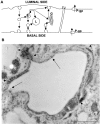Mechanisms of the penetration of blood-borne substances into the brain
- PMID: 19949573
- PMCID: PMC2730006
- DOI: 10.2174/157015909788848901
Mechanisms of the penetration of blood-borne substances into the brain
Abstract
The blood-brain barrier (BBB) impedes the influx of intravascular compounds from the blood to the brain. Few blood-borne macromolecules are transferred into the brain because vesicular transcytosis in the endothelial cells is considerably limited and the tight junction is located between the endothelial cells. At the first line of the BBB, the endothelial glycocalyx which is a negatively charged, surface coat of proteoglycans, and adsorbed plasma proteins, contributes to the vasculoprotective effects of the vessels wall and are involved in maintaining vascular permeability. In the endothelial cytoplasm of cerebral capillaries, there is an asymmetrical array of metabolic enzymes such as alkaline phosphatase, acid phosphatase, 5'-nucleotidase, adenosine triphosphatase, and nucleoside diphosphatase and these enzymes contribute to inactivation of substrates. In addition, there are several types of influx or efflux transporters at the BBB, such as P-glycoprotein (P-gp), multidrug resistance associated protein, breast cancer resistance protein, organic anion transporters, organic cation transporters, organic cation transporter novel type transporters, and monocarboxylic acid transporters. P-gp, energy-dependent efflux transporter protein, is instrumental to the barrier function. Several findings recently reported indicate that endothelial P-gp contributes to efflux of undesirable substances such as beta-amyloid protein from the brain or periarterial interstitial fluid, while P-gp likely plays a crucial role in the genesis of multiple vascular abnormalities that accompany hypertension. In this review, influx and efflux mechanisms of drugs at the BBB are also reviewed and how medicines pass the BBB to reach the brain parenchyma is discussed.
Keywords: Blood-brain barrier; P-glycoprotein; tight junction..
Figures


Similar articles
-
Transporters in the brain endothelial barrier.Curr Med Chem. 2010;17(12):1125-38. doi: 10.2174/092986710790827816. Curr Med Chem. 2010. PMID: 20175745 Review.
-
Role of drug efflux transporters in the brain for drug disposition and treatment of brain diseases.Prog Neurobiol. 2005 May;76(1):22-76. doi: 10.1016/j.pneurobio.2005.04.006. Prog Neurobiol. 2005. PMID: 16011870 Review.
-
Molecular anatomy of the brain endothelial barrier: an overview of the distributional features.Curr Med Chem. 2007;14(11):1199-206. doi: 10.2174/092986707780597943. Curr Med Chem. 2007. PMID: 17504140 Review.
-
Functional expression and localization of P-glycoprotein at the blood brain barrier.Microsc Res Tech. 2002 Jun 1;57(5):365-80. doi: 10.1002/jemt.10090. Microsc Res Tech. 2002. PMID: 12112443 Review.
-
Potential role of ABC transporters as a detoxification system at the blood-CSF barrier.Adv Drug Deliv Rev. 2004 Oct 14;56(12):1793-809. doi: 10.1016/j.addr.2004.07.009. Adv Drug Deliv Rev. 2004. PMID: 15381334 Review.
Cited by
-
Janus head: the dual role of HLA-G in CNS immunity.Cell Mol Life Sci. 2011 Feb;68(3):407-16. doi: 10.1007/s00018-010-0582-5. Epub 2010 Nov 18. Cell Mol Life Sci. 2011. PMID: 21086150 Free PMC article. Review.
-
Age-related immune alterations and cerebrovascular inflammation.Mol Psychiatry. 2022 Feb;27(2):803-818. doi: 10.1038/s41380-021-01361-1. Epub 2021 Oct 28. Mol Psychiatry. 2022. PMID: 34711943 Free PMC article. Review.
-
Drug and xenobiotic biotransformation in the blood-brain barrier: a neglected issue.Front Cell Neurosci. 2014 Oct 17;8:335. doi: 10.3389/fncel.2014.00335. eCollection 2014. Front Cell Neurosci. 2014. PMID: 25368552 Free PMC article.
-
Dexamethasone rescues neurovascular unit integrity from cell damage caused by systemic administration of shiga toxin 2 and lipopolysaccharide in mice motor cortex.PLoS One. 2013 Jul 23;8(7):e70020. doi: 10.1371/journal.pone.0070020. Print 2013. PLoS One. 2013. Retraction in: PLoS One. 2023 Dec 7;18(12):e0295781. doi: 10.1371/journal.pone.0295781. PMID: 23894578 Free PMC article. Retracted.
-
Progress in Borneol Intervention for Ischemic Stroke: A Systematic Review.Front Pharmacol. 2021 May 4;12:606682. doi: 10.3389/fphar.2021.606682. eCollection 2021. Front Pharmacol. 2021. PMID: 34017247 Free PMC article. Review.
References
-
- Bart J, Groen HJM, Hendrikse NH, van der Graaf WTA, Vaalburg W, de Vries EGE. The blood-brain barrier and oncology: new insights into function and modulation. Cancer Treat. Rev. 2000;26:449–462. - PubMed
-
- Bauer B, Hartz AWS, Fricker G, Miller DS. Modulation of P-glycoprotein transport function at the blood-brain barrier. Exp. Biol Med. 2005;230:118–127. - PubMed
-
- Bendayan R, Lee G, Bendayan M. Functional expression and localization of P-glycoprotein at the blood brain barrier. Microsc Res Tech. 2002;57:365–380. - PubMed
LinkOut - more resources
Full Text Sources
Other Literature Sources
Research Materials
Miscellaneous
